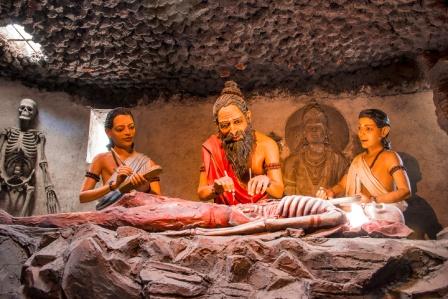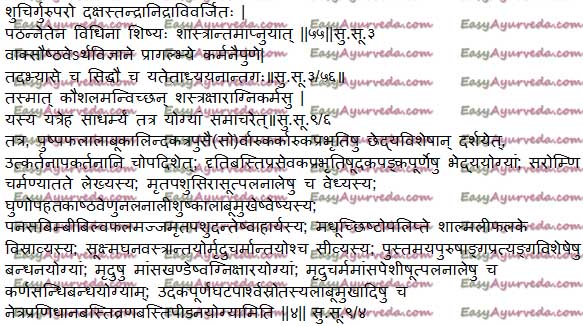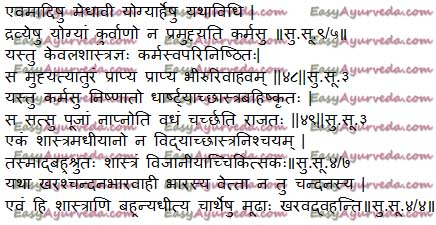Methods Of Surgical Training Elaborated In Ayurveda

By Dr Raghuram Y.S. MD (Ay) & Dr Manasa, B.A.M.S
Master Sushruta is known as ‘Father of Surgery’ and every reason which substantiates this designation can be found and appreciated when one reads the ancient textbook Sushruta Samhita.
Table of Contents
Introduction
It needs brains, heart, skills and courage to be a great surgeon. To be a surgeon one needs to be specially gifted.
Read – Procedure of surgical operation: Ashtanga Hrudaya Sutrasthana 29
We also have a famous quote which describes the qualities of an ideal surgeon. A surgeon should have –
- The eye of an eagle – which helps him to observe everything while at work, keenly
- The hands of a woman (ladies finger) – which enables him to handle the procedures in a gentle way
- The heart of a lion – to be courageous while conducting a surgery and take prompt decision and action
- The leg of a horse – which gives him strength and stamina to stand for long hours while conducting surgery
- The belly of a camel – which enables him to go without food and water for long hours while at surgery
Read – Ethics Of A Physician – Vaidya Vritti

For a surgeon to have all these qualities, he needs to undergo immense training in terms of both theory and practice. He cannot perform surgery by reading books. He must have been trained under a good surgeon.
Now a days, the surgical schools are very much sophisticated and equipped to train their students in a studious and tedious way until they perfect the art of surgery. The modern surgery too is an advanced science.
But we get a doubt so as to how the ancient schools of surgery, i.e. Shalya sampradaya or Dhanvantari sampradaya of Ayurveda taught their students when no facilities of the modern days were available.
Read – Oh My God! That Ayurveda Doctor Takes Allopathic Medicine!
Ayurvedic surgery training
Surgical training in ancient (Ayurvedic) surgical schools
The ancient schools and grand masters of Ayurveda, be it Charaka, Sushruta or Vagbhata have always advocated and encouraged the medical students to dedicate themselves in thorough learning of theoretical and practical aspects of both medicine or surgery.
Apart from theory and practical knowledge, the student of surgical medicine should learn
- medical and surgical ethics,
- code of conduct,
- self discipline,
- self control (over mind and senses),
- a good attitude and decency in terms of dressing,
- physical and mental attitude, speech and behaviour
Read – Sadvritta In Ayurveda – Code Of Conduct For Healthy Life
Any student becomes eligible to practice medicine or surgery only when he studies the subject with dedication while being pure, obedient to his teachers, being efficient at every step and is free from lethargy and sleep (laziness, pessimism).
Ayurveda has given importance and stressed upon the ethics of practice along with the importance of theoretical and practical excellence. A physician with good hold on theory and practical knowledge, yet lacking discipline and ethics of practice shall be a degraded physician and will not earn the respect of the people.
While the ethics of practice, rules and regulations a student needs to follow to excel in his medical and surgical career etc have been elaborated in the chapters like vishikanu praveshaneeya and sadvritta, the methods in which a student is trained in surgical methods so that he masters his skills in performing surgeries has been elaborated by Master Sushruta in the 9th chapter of Sutra Sthana named ‘Yogyaa Sutreeya Adhyaya’.
Read – Achara Rasayana – Behavioral Therapy For Calm Mind And Long Life
Yogyaa – it is the method of practising surgery on some dummy until one gets mastery over it. In order to perform a proper surgery on the living being and save lives, one should practice surgical methods on similar lifeless objects. The method in which it is practiced is called yogyaa.
Yoga – This mastery over the surgical procedures is called yoga.
Yogyaa sutreeya – The chapter in which the yogyaa is explained in basic understandable form is called yogyaasootreeya adhyaya.
Yogya – The student or surgeon who masters this art of surgery and becomes a surgeon, authorized, graduated and permitted to practice surgery is called yogya.
The teacher, in spite of having imparted immense knowledge and trained him perfectly in each and every subject, should make sure to see that his student becomes capable enough to bring his knowledge into practice, to become a good and intelligent practitioner by conducting himself properly in the society.
Read – Ksharasutra Advantages, Standardization, Recent Advances, History
The physician should train his student and supervise them performing various procedures individually until they master it. Under the guidance of a good teacher, surgical student should master in different surgical and para-surgical methods. They include –
- Sneha karma – oleation therapy
- Sweda karma – sudation therapies
- Chedana – cut / split / excision
- Bhedana – breaking / dividing / separation / incision / drainage
- Visravana – draining method
- Aaharana – extraction
- Seevana – suturing
- Yeshana – probing
- Bandhana – bandaging etc
Read – Sushruta’s 8 Types Of Surgical Procedures – Astavidha Shastra Karma
In spite of having a perfect theoretical knowledge, the medical student is not fit to practise until he has mastered on the procedures by doing each and every procedure all by himself, several times.
At the end of the training period, the teacher should make sure whether his student has become well versed in the below mentioned virtues –
- Vak shaoushtava – eloquence and communication skills
- Artha vijgnana – knowledge and mastery over the subject and special sciences
- Pragalbhya – excellence and mastery over everything
- Karma naipunya – skilled knowledge and perfection on all surgical / medical procedures
- Tadabhyasa – practical application of surgical and medical knowledge
- Siddhi – achievement of success, skills to become successful
In order to make his student well versed and perfect in every field, the teacher should demonstrate different techniques like surgical methods, alkali and fire cauterization etc, using experiments, models, specimens, dead bodies etc. He should demonstrate these procedures many times.
Read – Kshara Agnikarma Vidhi – Cauterization- Astanga Hridaya Sutrasthana 30
Later he should encourage the student to participate in doing the procedures under his guidance and later should be allowed to do those procedures individually. Once this part of training is completed, the student will be called as yogya (registered medical practitioner).
The student too should show his interest and master over one or all of the surgical procedures, fire cauterization and alkali cauterization. He should also learn how and when to use them skillfully and also practice them on appropriate models.
Read – KsharaSutra Pradhana Karma – Main Procedure
Shloka

Surgical training on models / dummies
In modern surgery this is called as ‘operative surgery’.
Chedana
Chedana means excision. Excision means the procedure of removing by cutting a diseased structure of the body. It can be called as surgical removal or resection.
Excision or amputation are demonstrated on the flowers, fruits, gourds, cucumber, bitter gourd etc. in these vegetables etc which have mentioned above, utkarshana i.e. upward incision and apakartana i.e. downward incision are demonstrated to cut our an organ or part of it.
Read – KsharaSutra Treatment: Introduction, Indication, Contra Indications
Bhedana
Bhedana means incision. It can also be understood in terms of paracentesis / tapping and letting out of fluids from the body.
This procedure is demonstrated on bladders filled with water and some thick solution like pankodaka i.e. muddy water.
Lekhana –
Lekhana is a scraping method.
Scraping is demonstrated on fine leather with scanty wool over it, wherein the wool is scraped off from the surface of leather using sharp instruments.
Read – Anal Fistula: Ayurvedic Concept, Types, Treatment
Vedhana –
Vedhana means puncturing / venesection.
Puncturing is demonstrated on the veins of dead animals or cadavers and also on stalks of lotus.
Read – Blood Letting Therapy – Siravyadha – Astanga Hrudaya Sutrasthana 27
Eshana –
Eshana karma means probing.
Probing is demonstrated on hollow sticks, bamboos, broom sticks and dried bottle gourds.
Aharana –
Aharana means extraction.
Extraction is demonstrated by removing the pulp / seeds of bael fruit, ivy gourd and the teeth of dead animals.
Read – Shringa Method Of Bloodletting Therapy – Procedure, Benefits
Raktamokshana –
Raktamokshana means bloodletting.
Bloodletting is demonstrated on plank of Salmalia malabarica smeared with bee wax.
Read – Raktamokshana Benefits, Types, Procedure, Indications
Sevana –
Seevana means suturing.
Suturing is demonstrated on thin or thick leather and clothes.
Bandhanam –
Bandhana means bandaging.
Bandaging and dressing is demonstrated on human models and dummy limbs and trunk or practically on the living individuals.
Read – Manage Your Pain Effectively By Applying A Loose Bandage
Agni karma – Kshara karma
Agni karma means fire cauterisation and Kshara karma means alkali cauterisation.
These two methods can be demonstrated on unsliced meat.
Basti / Vasti Karma –
Basti means enema.
Giving enemas are demonstrated and douches are demonstrated on water filled pots / cans and holes of dried bottle gourd.
Read – Basti Chikitsa: Benefits, Routes, Types, Indications, Equipment
Karna sandhibandhanam –
Karna sandhibandhanam means ear lobe repair.
Ear lobe repair shall be demonstrated on soft leather, muscles and stalk of lotus.
The teachers should make their students well equipped with experimental surgery on models and specimens as explained above and then allow him to practice surgical methods on the patients.
The intelligent and learning enthusiast student will continuously practice on the models designed to be practised on regular basis will master the art of surgical processes in such way that he will never fear or fumble while conducting the surgical procedures on the patients.
Read –Injury, Wound care -Ayurvedic Remedies, Medicines

Importance of precision
Importance of having practical precision in surgical methods and practices
The student who has studied the science only in its theoretical aspect and has not undergone the training in its practical aspect, nor does he have any practical experience, will run away from the patient while it comes to conducting surgical procedures, just like an ill-experienced soldier runs away from the battle field. Therefore practical approach, learning and experience are necessary for a surgical student.
Similarly, the student of surgical school / medicine who is well trained practically, but out of his pride and over-confidence or due to negligence does not learn anything theoretically will not be respected in the society.
Read – How To Understand And Master Ayurvedic Medicines Easily
These references indicate that even during ancient time, unqualified, untrained and unregistered medical practitioners and quacks were not allowed to practice. Only the physicians and surgeons who are well versed in both theoretical and practical experience were allowed to practice.
Master Sushruta also has emphasized the importance of physicians having contemporary and parallel knowledge of allied sciences. They would not only add to the wisdom of the physician but also enrich one’s knowledge in medical science. He can adopt the knowledge of allied sciences in his medicinal practice and gain more success.
Read – Learn Ayurvedic Principles And Ashtanga Hrudayam Easily
One cannot arrive at a decisive knowledge by learning only one science i.e. Ayurveda alone (in this context). Therefore one must show interest and also study several of the contemporary sciences to become a good physician or surgeon.
In olden days, a student of Ayurveda would learn Siksha, Vyakarana, Chandas, Mimamsa, Nyaya, Kalpa, Darshanas, Kama Shastras, Neeti Shastra, Sanskrit etc allied subjects apart from the medical subjects / subjects of surgery.
Read – 18 Tips for a New Ayurvedic Student
‘One cannot become a good physician just by learning or memorizing the verses in the treatises’
A scholar who memorises the texts and the verses therein and doesn’t understand their meaning and sense is similar to that donkey which can only appreciate the weight of the sandalwood which it carries on its back but can never appreciate its fragrance.
Is surgery possible in Ayurveda?
Surgeries involving Ksharasutra, Ksharakarma for piles, fistula, fissure, non healing wounds, abscess, gangrene, skin grafting, pilonidal sinus, wart, corns, phimosis, keloid, cupping therapy, lipoma, lobuloplasty, breast abscess, herpes, necrotizing fasciitis, osteomyelitis, etc., – we have male and female Ayurvedic surgeons who cater to respective patient groups. Our male surgeon –
Dr Ashwin Jayaram Shetty BAMS MS (Ayu) Consult online https://www.easyayurveda.com/ashwin/
Our female Ayurvedic surgeon –
Dr Abhinethri Hegde BAMS MS (Ayu) Consult online https://www.easyayurveda.com/hegde/ Call to book appointment at Easy Ayurveda Hospital, Mangaluru +91 86188 98900 Whatsapp: +91 88673 85567









